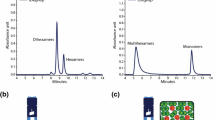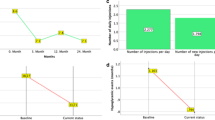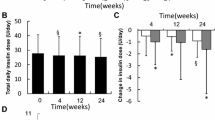Abstract
Insulin degludec/aspart (IDegAsp) is the first soluble insulin co-formulation, combining a long-acting insulin degludec (IDeg) and rapid-acting insulin aspart (IAsp). In type 2 diabetes patients with oral antidiabetes agent (OAD) inadequacy, insulin initiation with IDegAsp once daily provides superior long-term glycemic control compared to insulin glargine, with similar fasting plasma glucose (FPG) and insulin doses, and numerically lower rates of overall and nocturnal hypoglycemia. Furthermore, in patients with uncontrolled type 2 diabetes previously treated with insulins, IDegAsp twice daily effectively improves glycated hemoglobin and FPG, with fewer hypoglycemic episodes versus premix insulins and basal bolus therapy. In patients with type 1 diabetes mellitus, IDegAsp once daily with two doses of IAsp is a convenient, yet effective, regimen as compared to the conventional 4–5 injection-based basal bolus therapy. IDegAsp is an appropriate and reasonable option for initiation of insulin therapy in both type 1 and type 2 diabetes.
Similar content being viewed by others
Avoid common mistakes on your manuscript.
Introduction
Type 2 diabetes is a progressive disease. The addition of insulin to provide mealtime coverage is needed when oral antidiabetes agents (OADs) and a basal regime of insulin are no longer enough to establish or maintain glycemic control [1]. Existing basal bolus regimens offer both basal and precise postprandial glucose control, but as separate injections [2]. Many patients are reluctant to start with a basal and bolus insulin regimen because of its complexity, the added need to calculate a prandial dose, the need for two injections, and a fear of hypoglycemia [3]. IDegAsp, is a modern insulin co-formulation approved in more than 70 countries across the world [4]. It is a preformulated fixed-ratio combination of rapid-acting insulin aspart (IAsp) (30%) and ultra-long acting insulin degludec (IDeg) (70%). IDegAsp is marketed as a prefilled disposable pen, as well as in pen fills that can be used with durable pens [5].
Versatility and Flexibility
IDegAsp is a unique formulation that shows great versatility and flexibility. IDegAsp works as both premix and basal plus regimens, and can substitute for basal bolus regimens as well. It can be used once daily, twice daily, or as part of a thrice daily regimen (one IDegAsp and two IAsp doses). Thus, IDegAsp allows freedom and flexibility in diabetes care [6].
Size exclusion chromatography studies of IDegAsp indicate that IDeg and IAsp exist as stable dihexamers and hexamers, respectively, in the formulation [7]. Moreover, at steady state, the prandial and basal glucose-lowering effects of IDeg and IAsp were distinct and clearly separated. A clear dose–response relationship was observed in patients with type 1 and type 2 diabetes treated with IDegAsp [8]. The glucose-lowering effects of basal and prandial components of IDegAsp are maintained in elderly (≥ 65 years of age) patients with type 1 diabetes [9]. In addition, the PK and clearance of IDeg and IAsp are not affected by mild, moderate, or severe renal or hepatic impairment [8]. The presence of two distinct insulin analogues as a soluble co-formulation of a basal component with an ultra-long duration of action makes IDegAsp an advance over earlier premix insulins. To overcome the burden of multiple daily injections, co-formulating basal and bolus insulins in a single injection could allow a simple regimen with fewer injections [6].
Evidence from Randomized Controlled Trials
This article is based on previously conducted studies and does not contain any studies with human participants or animals performed by any of the authors.
The efficacy and safety of IDegAsp were evaluated in the BOOST clinical trial program. BOOST was a phase 3 trial designed to represent a large population of diabetes from various geographic areas. IDegAsp has been studied in both type 1 and type 2 diabetes and it has been used in once daily or twice daily regimen [10,11,12,13,14,15].
In a Japanese study, comparing IDegAsp once daily with insulin glargine (IGlar) once daily for 26 weeks in insulin-naïve type 2 diabetes patients, IDegAsp demonstrated superiority in terms of HbA1c reduction, which was achieved as a result of the reduction in fasting plasma glucose (FPG) and evening meal postprandial glucose (PPG). The superiority was realized with less risk of nocturnal and overall hypoglycemia with IDegAsp [10].
IDegAsp has also been studied in a twice daily regimen in comparison to basal bolus therapy in type 2 diabetes mellitus (T2DM) patients. IDegAsp achieved similar efficacy with less risk of hypoglycemia, with a reduction in the overall dose and fewer self-monitoring blood glucose values required compared to the basal (IDeg) bolus (IAsp) regimen [11].
When compared to premix, IDegAsp has consistently demonstrated effective glycemic control with superior FPG reduction and less risk of both nocturnal and overall hypoglycemia [12, 13].
In a study performed in type 1 diabetes, comparing IDegAsp once daily with insulin detemir (IDet) + mealtime IAsp, both the arms revealed that IDegAsp achieved similar HbA1c with better FPG reduction and less risk of nocturnal and overall hypoglycemia [14].
Real-World Evidence
The efficacy and tolerability data of IDegAsp are supported by real-world evidence across the globe. Kaneko et al. illustrated that IDegAsp provided a simple, helpful intensification for poorly controlled T2DM patients on OADs, special populations in whom it is difficult to escalate/intensify insulin therapy, and T2DM patients dosed with conventional premix [15]. Kalra and Baruah presented 1-year data from India highlighting the efficacy, safety, and tolerability of IDegAsp in patients with poor glycemic control [6]. Results from the major clinical studies on IDegAsp are summarized in Table 1.
All the evidence suggests that a co-formulation of basal and bolus insulin allows for basal and prandial coverage with fewer injections compared to basal and bolus therapy whilst offering simplicity and convenience. The comprehensive fasting and prandial control achieved with this preparation is especially useful for people who consume high carbohydrate meals, as in Africa, Asia, and Latin America.
Eminent Experience
An earlier multinational consensus identified and defined seven patient profiles in which IDegAsp can be a preferred choice of insulin preparation. Of these profiles, five relate to type 2 diabetes, and two to type 1 diabetes [16]. IDegAsp is described as an insulin for initiation in two, intensification in three, and interchange in two clinical profiles. A South Asian consensus statement provides pragmatic guidance regarding the safe and effective use of IDegAsp during Ramadan [17].
Concordance
Current guidelines released by the American Diabetes Association (ADA) acknowledge the role of premix insulin in the management of type 2 diabetes. Both premix and basal plus insulin regimens are suggested as an option for intensification of insulin. Intensive insulin regimes are also listed as a therapeutic choice in persons presenting with hyperglycemic symptoms or cachexia [18].
As discussed earlier, the versatile IDegAsp preparation can be used as a premix, basal plus, or basal bolus regimen. It can also be used for once daily initiation of insulin in place of basal insulin. Therefore, there is a need to revisit the use of IDegAsp and highlight its concordance with current ADA guidelines.
While the earlier consensus has described the clinical utility of IDegAsp in detail, a focus is required on earlier use of appropriate insulins. This implies initiation of the right insulin at the right time. This multinational consensus, therefore, seeks to define the situations where IDegAsp can be used for initiation of insulin therapy. It also suggests simple clinical tips that will help promote efficient implementation of IDegAsp.
Consensus: Initiation with Insulin Degludec/Aspart (IDegAsp)
Indications
-
The consensus group recommends the use of IDegAsp for initiation of insulin in
-
Drug-naïve persons with
-
Symptoms of hyperglycemia.
-
High carbohydrate diet.
-
High HbA1c.
-
High postprandial excursion.
-
Insulin-naïve persons with inadequate response to metformin, dual or triple oral therapy.
-
Long-acting sulfonylureas and IDegAsp, if used together, should be administered at antipodal meals.
-
Administration and Titration
-
The consensus group recommends the use of IDegAsp for insulin initiation in once daily or twice daily subcutaneous dosage, depending upon
-
Meal pattern and quantity
-
Gluco-phenotype (glucose profile)
-
-
The starting dose of IDegAsp is usually 10 U or 0.1–0.2 U/day, but will vary according to
-
Severity of hyperglycemia
-
Risk of hypoglycemia
-
Meal pattern and quantity
-
Weight of the patient
-
The consensus group recommends titration of IDegAsp to be performed using a simple 2-0-2 algorithm (add 2 U if target fasting or premeal glucose is not achieved; zero change if target is achieved; reduce by 2 U if hypoglycemia occurs).
-
IDegAsp use should be monitored by regular self-monitoring of blood glucose
-
Twice weekly when glycemic control is unstable, hypoglycemia is anticipated, or urgent resolution of hyperglycemia is needed.
-
Once weekly when glycemic control is stable and no fluctuations are anticipated.
-
More frequently if glycemic control is brittle.
-
Once prebreakfast and predinner control is achieved, postprandial glucose monitoring can be done to titrate doses further.
-
Advantages
As compared to other insulin regimens and preparations, IDegAsp provides
-
Glycemic control better or equivalent to
-
Basal regimen, if used once daily
-
Basal plus regimen, if used once daily
-
Basal bolus regimen, if used twice daily
-
Premix therapy
-
-
Flexibility in timing of administration
-
Lower risk of
-
Hypoglycemia
-
Nocturnal hypoglycemia
-
Special Situations
The consensus group recommends IDegAsp should not be used
-
In pregnancy and lactation
-
As the only insulin in diabetic ketoacidosis
-
Intravenously
The consensus group recommends IDegAsp to be used safely in special situations such as
-
Shift workers/those with erratic meal patterns
-
Ramadan fasting
-
Renal impairment
-
Hepatic impairment
-
Elderly population
The consensus group recommends IDegAsp to be initiated as part of a three-dose regimen (IAsp–IAsp–IDegAsp) in
-
Type 1 diabetes
-
Persons in whom early correction of hyperglycemia is required
Conclusion
This consensus provides information on the efficacy, safety, and ease of administration of IDegAsp in comparison with other insulin regimens and highlights the benefits of IDegAsp. It also provides a simple consensus for the use of IDegAsp in various populations with an algorithm for dose titration.
Change history
07 June 2018
Unfortunately, the fifth author name was incorrectly published in the original publication. The correct name should read as ‘Ozgur Demir’.
References
Garber J. The importance of titrating starting insulin regimens in patients with type 2 diabetes. Diabetes Obes Metab. 2009;11(5):14–8.
Inzucchi S, Bergenstal R, Buse J, et al. Management of hyperglycemia in type 2 diabetes: a patient-centered approach. Diabetes Care. 2012;35:1364–79.
Nathan M, Buse J, Davidson B, et al. Medical management of hyperglycemia in type 2 diabetes: a consensus algorithm for the initiation and adjustment of therapy. Diabetes Care. 2009;32:193–203.
COMUNICADO: Ryzodeg® Significantly reduces the risk of low blood sugar in people with type 2 diabetes who fast during Ramadan. http://www.europapress.es/comunicados/internacional-00907/noticia-comunicado-ryzodeg-significantly-reduces-the-risk-of-low-blood-sugar-in-people-with-type-diabetes-who-fast-during-ramadan-20171207094659.html. Accessed 12 Feb 2018.
Ryzodeg® Summary of product characteristics 2015. http://www.ema.europa.eu/docs/en_GB/document...Product.../WC500139011.pdf. Accessed 16 May 2018
Kalra S, Baruah M. Insulin degludec aspart: one-year real world experience. Indian J Endocrinol Metab. 2016;20(3):369–71.
Havelund S, Ribel U, Hubalek F et al. Insulin degludec (IDeg) and insulin aspart (IAsp) can be co-formulated such that the formation of IDeg multi-hexamers and IAsp monomers is retained upon s.c. injection. In: Poster presented at ADA 2013 Chicago. 945P.
Haahr H, Fita E, Heise T. A review of insulin degludec/insulin aspart: pharmacokinetic and pharmacodynamic properties and their implications in clinical use. Clin Pharmacokinet. 2017;56:339–54.
Brunner M, Pieber T, Korsatko S, Kojzar H, Svendsen AL, Haahr H. The distinct prandial and basal pharmacodynamics of IDegAsp observed in younger adults are preserved in elderly subjects with type 1 diabetes. Drugs Aging. 2015;32:583–90.
Onishi Y, Ono Y, Rabol R. Superior glycaemic control with once–daily insulin degludec/insulin aspart versus insulin glargine in Japanese adults with type 2 diabetes inadequately controlled with oral drugs: a randomized, controlled phase 3 trial. Diabetes Obes Metab. 2013;15:826–32.
Rodbard HW, Cariou B, Pieber TR, Endahl LA, Zacho J, Cooper JG. Treatment intensification with an insulin degludec (IDeg)/insulin aspart(IAsp) co-formulation twice daily compared with basal IDeg and prandial IAsp in type 2 diabetes: a randomized, controlled phase III trial. Diabetes Obes Metab. 2016;18:274–80.
Franek E, Haluzík M, Canecki Varžić S, et al. Twice-daily insulin degludec/insulin aspart provides superior fasting plasma glucose control and a reduced rate of hypoglycaemia compared with biphasic insulin aspart 30 in insulin-naïve adults with type 2 diabetes. Diabet Med. 2016;33:497–505.
Fulcher GR, Christiansen JS, Bantwal G, et al. Comparison of insulin degludec/insulin aspart and biphasic insulin aspart 30 in uncontrolled, insulin-treated type 2 diabetes: a phase 3a, randomized, treat-to-target trial. Diabetes Care. 2014;37:2084–90.
Hirsch IB, Franek E, Mersebach H, Bardtrum L, Hermansen K. Safety and efficacy of insulin degludec/insulin aspart with bolus mealtime insulin aspart compared with standard basal-bolus treatment in people with type 1 diabetes: 1-year results from a randomized clinical trial (BOOST T1). Diabet Med. 2017;34:167–73.
Kaneko S, Chow F, Choi S. Insulin degludec/insulin aspart versus biphasic insulin aspart 30 in Asian patients with type 2 diabetes inadequately controlled on basal or premixed insulin: a 26-week, randomised, treat to-target trial. Diabetes Res Clin Pract. 2015;107:139–47.
Kalra S, Latif A, Comlekci A, et al. Pragmatic use of insulin degludec/insulin aspart co-formulation: a multinational consensus statement. Indian J Endocr Metab. 2016;20(4):542–5.
Kalra S. Insulin degludec and insulin degludec/insulin aspart in Ramadan: a single center experience. Indian J Endocrinol Metab. 2016;20(4):564–7.
American Diabetes Association. Introduction: standards of medical care in diabetes—2018. Diabetes Care. 2018;41(1):S1–2.
Acknowledgements
Funding
No funding or medical writing support has been received for this study or publication of this article.
Authorship
All named authors meet the International Committee of Medical Journal Editors (ICMJE) criteria for authorship for this article, take responsibility for the integrity of the work as a whole, and have given their approval for this version to be published.
Disclosures
Sanjay Kalra has received speaker fees from NovoNordisk, Sanofi Aventis, and Eli Lilly. Rachid Malek has received honoraria from Novo Nordisk. Roopa Mehta has received honoraria from Novo Nordisk, Boehringer Ingelheim, Amgen, AstraZeneca, Janssen, MSD, Novartis, Stendahl, and Abbott. Sundeep Ruder has received speaker fees and ad board honoraria from Novo Nordisk, AstraZeneca, Abbott, and Boeringher; speaker fees from Novartis. All other authors, Stephen Atkin, Antonio Cervera, Ashok Kumar Das, Ozgur Demir, Tevfik Demir, Md Fariduddin, Khoa Tuan Vo, Bon Jeong Ku, Ajay Kumar, Zafar A. Latif, Bien Matwaran, Nam Quang Tran, Araceli Panelo, Joel Rodriquez Saldana, Khalid A. Shaikh, Amit Shakya, Dina Shrestha, and A. G. Unnikrishnan, have nothing to disclose.
Compliance with Ethics Guidelines
This article is based on previously conducted studies and does not contain any studies with human participants or animals performed by any of the authors.
Open Access
This article is distributed under the terms of the Creative Commons Attribution-NonCommercial 4.0 International License (http://creativecommons.org/licenses/by-nc/4.0/), which permits any noncommercial use, distribution, and reproduction in any medium, provided you give appropriate credit to the original author(s) and the source, provide a link to the Creative Commons license, and indicate if changes were made.
Author information
Authors and Affiliations
Corresponding author
Additional information
The original version of this article was revised: The fifth author name ‘Ozgur Demir’ was misspelled in the original publication.
Enhanced Digital Features
To view enhanced digital features for this article go to https://doi.org/10.6084/m9.figshare.6216395.
Rights and permissions
This article is published under an open access license. Please check the 'Copyright Information' section either on this page or in the PDF for details of this license and what re-use is permitted. If your intended use exceeds what is permitted by the license or if you are unable to locate the licence and re-use information, please contact the Rights and Permissions team.
About this article
Cite this article
Kalra, S., Atkin, S., Cervera, A. et al. Multinational Consensus: Insulin Initiation with Insulin Degludec/Aspart (IDegAsp). Adv Ther 35, 928–936 (2018). https://doi.org/10.1007/s12325-018-0712-2
Received:
Published:
Issue Date:
DOI: https://doi.org/10.1007/s12325-018-0712-2




